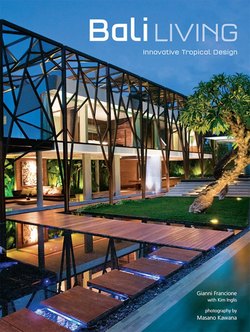Читать книгу Bali Living - Gianni Francione - Страница 11
На сайте Литреса книга снята с продажи.
ОглавлениеThe modernist villa compound of this Indonesian businessman is dominated by a metal framework “roof” that stretches over the largest building. Both practical and aesthetic, it is composed from ulin wood and steel. The compound itself is imaginatively constructed over a number of different levels, using asymmetry as an overriding motif. Architect, Andra Matin, describes this as a “non-linear spatial experience, both horizontally and vertically”. On left, a sculptural wooden teak root emerges from a reflecting pool; it goes some way to balancing the presence of the imposing, inclined frangipani tree in the middle of the compound.
The open-air living area in the double-height building is characterized by low-level tables in teak and simple merbau wood couches, designed to the owner’s specification. Lime-green and beige cushions with a tree motif and purple upholstery offset a large modern painting by Indonesian artist Yuswantoro Adi.
The two-storey building is open air below and enclosed above.
The frangipani tree (Plumeria sp), ubiquitous in the tropics, is planted extensively in Bali because of its sweet scent, interesting shape and for its cultural and religious significance. The blooms are frequently used in an assortment of decorative and ceremonial purposes. On this Seminyak site, a number of old frangipani trees, leaning in various contorted directions, cast their pristine flowers on the grass and their shade over swathes of lawn. They also serve as the inspiration for the design of the single outstanding architectural statement in this compound—an audacious steel roof framework.
It’s the most eye-catching feature here—and not only because of its size and shape. Projecting over the entire mass of the only double-storey building in the compound, it seems to have a life of its own. “The framework derives its shape from the branches of the frangipani,” explains Jakarta-based architect Andra Matin. “Creeping vertically and hovering horizontally over the concrete roof deck, it is extremely expressive.” Consisting of steelwork clad in wood, it is both artistic and functional: it makes a strong sculptural statement and shields the flat concrete roof from direct heat and tropical rain.
Beneath its intricate webbing is a two-storey structure that stretches in an east-west alignment. The ground floor, entirely open to the elements, houses a living, dining and pantry area, while above are two children’s bedrooms. According to Matin, the building is inspired by the traditional Asian stilt house where lower levels are open to the elements and enclosure is only made at the upper levels. Throughout the day, the living quarters benefit from cross breezes, ample sunlight and a seamless connection to the surrounding gardens.
